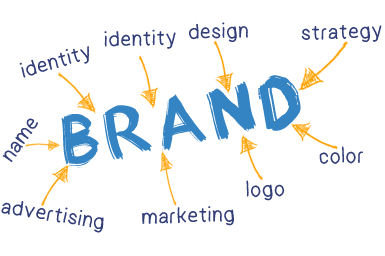
Find out why you should develop your brand strategy – and not just your brand logo – right from the beginning of your business journey.
Welcome to the rollercoaster world of the startup – where exhilarating highs, a few ‘eek’ moments and lots of life-changing experiences are guaranteed.
But amongst all the growing and building every startup goes through, there’s one constant that can help keep your business focused and maintain its integrity, and that’s your brand.
What is a brand, exactly?
According to marketing guru Seth Godin, brand is: “The set of expectations, memories, stories and relationships that, taken together, account for a consumer’s decision to choose one product or service over another.”
In other words, your brand exists in the mind of your customer, and it’s a result of everything your business does that makes an impression on them.
Far from being a matter of superficial color and design, a strong brand runs right the way through your business like DNA. It reflects and unites your values, your practices and what you started this epic journey for in the first place.
Here are 7 branding tips for companies thinking about branding for the first time
Prioritize your brand from day one
When you’re in the early days of your startup, brand strategy might seem like a nice-to-have as you focus on getting products out the door and bringing in income to prove your worth to investors.
But as we always advice at Ready Apples, the nature of your brand isn’t something to overlook, particularly in those crucial early days. Brands have a way of emerging and evolving spontaneously, unless you make the effort to define them and control them in a conscious way. You don’t believe right? Look at the case of “ONLY FANS”.
This is something that’s much easier to do when your business is in its early days and your team is small and open to new ideas.
Developing a coherent brand isn’t just about future-proofing though. It can also help you stand out in a crowded market and make your business more memorable to potential customers.
Define what influences your brand
Your brand is your business personality, and like a human’s personality, it is expressed in multiple ways. It’ll be reflected in your logo, your brand colors, your graphic style and your tone of voice. Then there’s your brand values – the traits that characterize how you do business and how the people within your company think, feel and behave.
Of course, you’re not robots, which means your brand is going to be nuanced and changing as it reflects the people and personalities that make up your small business.
It can be helpful to think of your brand as a summary or description of who you are at your best, rather than a set of rules about who you are supposed to be at all times.
Think about your target audience
Your brand has both an internal role and an external one. On the internal side, it helps unify your business goals and give staff a sense of connectedness and purpose. Externally, your brand determines how your business is perceived in the minds of your target audience.
You’ve probably already got a sense of the kind of people who are likely to be interested in your products, particularly if you’ve recently gone through the process of developing a business plan. They will make up a big part of your target audience.
However, there are also some audience groups you may not have thought of. These could include people who might want to work for your company, who may be more interested in your way of doing business and the kind of skills you use than in your products. Then there are journalists, bloggers and influencers who may want to feature your business in a story or collaborate with you on some content.
There will also be audiences you can’t necessarily predict when you start out. Customers may find ways to benefit from your products or services that aren’t what you originally intended, so it’s important to keep an open mind and a listening ear to make sure you’ve got an up-to-date picture of your brand’s different audience groups.
Also Read: What you need to know before starting a business
Assess your brand from an objective perspective
Objectivity is an important quality for startups, as Ready Apples points out. It’s easy to fall in love with the idea behind your business and skip over any other reactions people might have, such as confusion (‘what is it?’), not recognizing the benefits (‘why do I need it?’) and mistrust (‘who are you guys anyway?’).
Focusing on the whole brand experience, including the product concept, sales journey and interactions with your marketing channels, is crucial to getting it right.
Connect brand strategy with marketing
Your marketing strategy and your brand will naturally dovetail together, so when you’re starting out it’s a good idea to develop the two in parallel. As a small business, you have a natural advantage here, because you’ll have a smaller number of personnel and be more agile compared to a larger company – everyone will fit in a single meeting room, for a start.
Working together, you’ll need to think about the marketing channels you will use, such as social media platforms, email, website, events, speeches or content marketing, and what kind of role they play in your plans. Each of these channels will express your brand and bring in useful information from your audiences about how your business is perceived.
There are many ways marketing can influence how your brand comes across. For example, the design of your marketing materials, the frequency of different kinds of communications such as emails or tweets, the topics you cover in content marketing activities such as a blog or video channel, and the tone of voice you use.
Marketing channels can have a brand management role, too. Increasing your brand awareness, i.e. the level of understanding your consumers have of your brand and how they interpret it, is often a strategic goal for new businesses. That’s something you can assess by listening to your audience through conversational channels like social media.
Differentiate your brand from competitors
Your brand is a reflection of who you are as a business, so it’s going to be uniquely you. But there’s no denying that certain industries tend to develop a common brand ‘language’, where certain colors, fonts, illustration styles or even a tone of voice are typical across multiple businesses.
That doesn’t have to be a bad thing, but it’s definitely something to be aware of and make a conscious decision about. You need to decide whether you want to tap into your industry’s brand trends, or break the mold with something truly unique.
If you’re a design business, you’ll also be working with client’s brands and interpreting them in your own style.
Also Read: Making Money Online: High-paying Online jobs
Use audits to keep your brand in tip-top shape
Once you’ve developed your brand and your business has been up and running for a while, it’s a good idea to check in regularly with a brand audit every six months or every year. A brand audit is an internal process that helps you keep track of how consistently your brand comes across, how well it aligns to the way you do business, and how it’s perceived by your customers.
After all, your brand is a reflection of how you do things, and all being well, your startup will have blossomed into something bigger, bolder and brighter over the space of a year.
Speak with a brand strategist now, to give your brand the right competitive advantage!
















